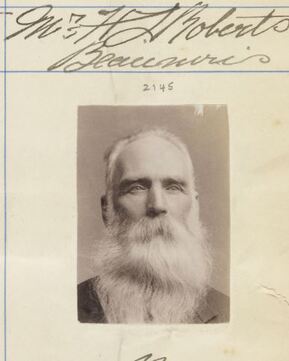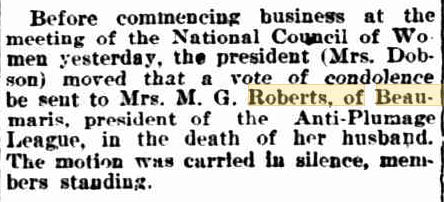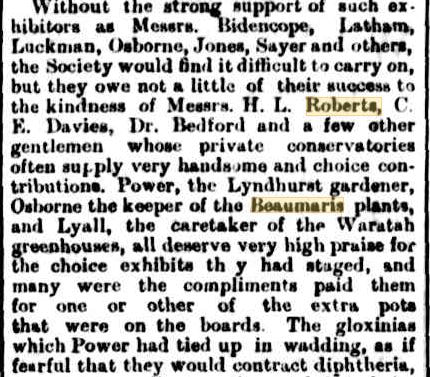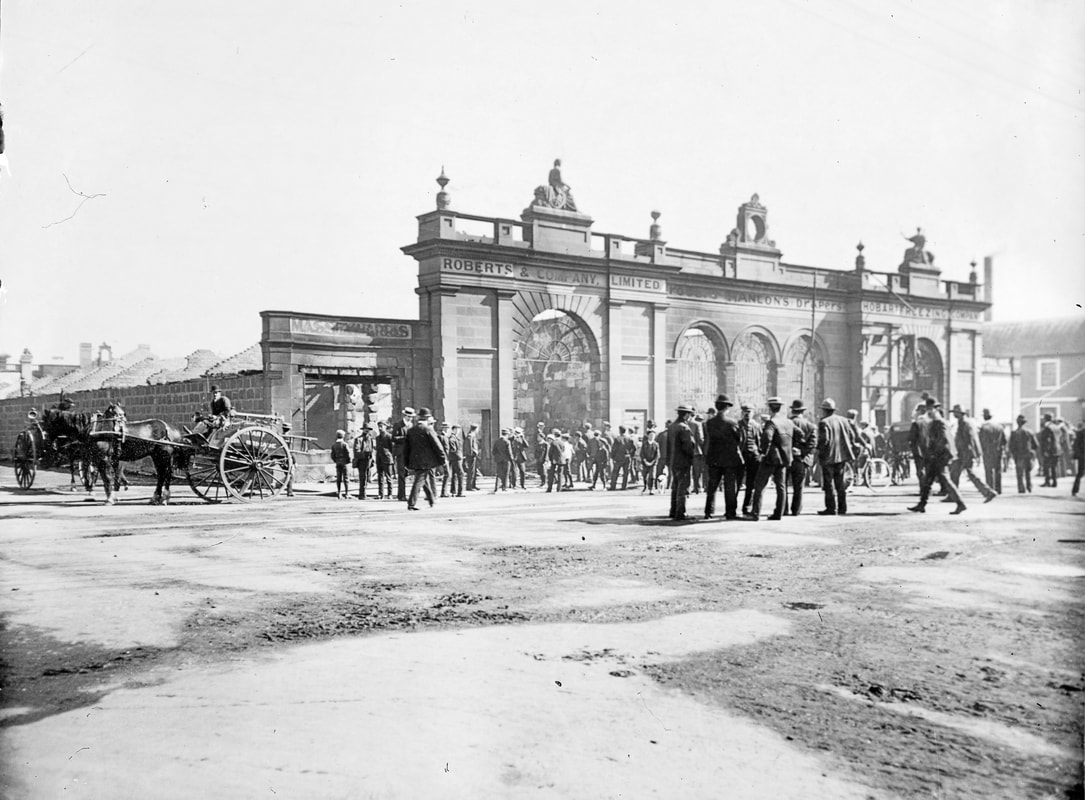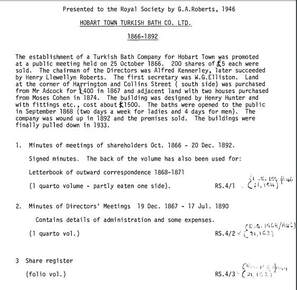Henry Llewelyn Roberts
|
|
DEATH OF MR. H. L. ROBERTS.
Mr Henry Llewelyn Roberts, of the well-known firm of Roberts and Co Ltd , passed away yesterday afternoon at his residence, Beaumaris, Battery Point at the age of 88. The deceased was the son of the late John Roberts, who was present at the battle of Waterloo in 1815, being employed in the commissariat department. Eight years later he came to Hobart with his wife and family, and was chief clerk in the commissariat department here. His youngest son who died yesterday, was born in 1831, in Liverpool street, in a house which is still standing opposite the General Hospital. Going in for a commercial life, deceased in 1864 was engaged as accountant with the firm of Brent and Westbrook, auctioneers, but leaving that firm the same year, he and the late Mr. G. A. Kemp, with the late Mr. W. J. Abbott, founded the firm of Kemp, Roberts, and Abbott. The following year Mr. Kemp left the business and in 1870 Mr. H. R. Brent, New Town road, who is still a director, having been a member of the firm for 48 years, joined as a partner, the business being carried on by these three gentlemen under the name of Roberts and Co., until the firm was sold out to Roberts and Co. Ltd. in 1888, deceased being managing director until 1911, and a director up to the time of his death. He had unfailing good health up to a few weeks ago. Being of a retiring disposition, he took no part in public life, most of his activities being of a private nature. The Turkish Bath in Harrington-street owes its inception to the deceased, who was the recipient of presentation plate given to him in connection with the opening. He was greatly devoted to music, and took deep interest in the work of the old Orchestral Union. He leaves a widow, two sons (both of whom are in the business), and two daughters, one of whom is a widow residing in New South Wales. will - https://stors.tas.gov.au/862072# |
https://stors.tas.gov.au/NS1013-1-1526
OFFICIAL NOTICES. 25 July 1866 (From Yesterday's Gazette.) An auctioneer's license has been issued to Henry. L Roberts, of Hobart Town THE NEW TURKISH BATH. 14 Sept 1868 trove.nla.gov.au/newspaper/article/8854509/779063 The Turkish Bath Company have now completed their establishment at the corner of Collins and Harrington-streets, and on Wednesday the bath is to be open to the public, under conditions contained in the advertisement which will be found in another column. The manner in which the building has been designed and finished reflects the highest credit upon all concerned ; every arrangement is perfect, and a more luxurious bathing establishment does not exist, we feel assured, in any of the colonies. The exterior of the building presents no very remarkable feature ; economy was a condition forced upon the directors, and for that reason money was not expended upon architectural adornment. The building is of plain red brick with dressed quoins, the walls being relieved merely by the small windows by which the interior is lighted, and which, to secure privacy are at a height of about ten feet from the ground. The apartments consist of an entrance hall, pay office, frigidarium, or lounging room, dressing rooms, bath room, and calidarium, or hot-air room. Entering by the main door, the visitor finds himself in the hall, which is covered with oil cloth, and contains a rack of large-sized pigeon holes or boxes, numbered, which are designed to receive the boots of the bathers. The window of the pay office opens upon this apartment, and a clerk will receive the bathing fee, and also take charge of any valuables which the visitor may wish to deposit while engaged in the bath. Drawing aside a green curtain, the visitor enters the lounging room, a large handsome apartment furnished, not in a style of oriental splendour, but with simple European taste. The floor is covered with a rich Brussels carpet, and arranged around the room are six mechanical lounges upholstered in green leather. These are constructed somewhat upon the principle of invalid lounges, and can be fixed so as to enable the bather to recline in any posture. Beside each lounge stands a neat circular table. There are besides a number of comfortable American lounging chairs. In the centre of the apartment is a large table with a pair of cheval glasses and other conveniences of the toilette. Surrounding the room and opening upon it are a dozen of dressing apartments or boxes, curtained with green damask, each containing a seat and hooks for hanging up articles of dress. In these the bather will unrobe, and attired in a light wrapper pass into the bathing room where the process of the bath will be commenced. He will then enter the calidarium, and this is the principal feature of the bath. The calidarium consists of two apartments, in the smaller of which is the hot air furnace. This is a large square iron box, so constructed within as to cause the air to pass through a number of tubes and to become thoroughly heated. It then passes from the furnace, through a large main, running along the ceiling of the apartment, and escapes through a smaller pipe, the end of which is open passing through the room, and being again drawn back to feed the fire of the furnace, and to repeat its circuit. By this contrivance the most perfect ventilation is secured, and a constant current of hot air is kept moving through the apartment. The floor is of Roman cement, and flush with the lower portion of the furnace, so that no crevice exists for the accumulation of foul air. Around the room plain deal benches are arranged, and on these the bather may sit or recline, until the skin has become thoroughly active. The temperature of the larger apartment is to be maintained at about 130 degrees, that of the smaller will range to 180 degrees. Having had enough of the heating room the bather returns to the bathing room, where he will be laid upon a table and dealt with by the shampooer. After this process he will step into the rain bath, a very luxurious contrivance, and the most attractive feature of the whole process. The rain bath is a circular box surrounded with hoops of piping ranging from the top to the bottom, and all minutely perforated. To this both hot and cold water are laid on with considerable pressure. First the hot water tap is turned and a hot shower bursts forth on every side ; gradually the hot is turned off while the cold is being turned on and so the shower is reduced in temperature until it is perfectly cold. After this, should the bather desire it, he may enjoy the douch bath. This is a simple stream of cold water descending from a height of about twenty feet. The bather next passes into a lavatory where towels are provided, and having been thoroughly dried he is enveloped in a sheet and left to lounge at pleasure in the principal apartment. The directors of the company have secured the services of an Indian shampooer and his wife, who have both been for six or seven years connected with the Turkish Bath in Sydney, and who are therefore thoroughly experienced. The establishment will be set apart on two days in each week for the use of ladies, and there can be little doubt but it will be very largely patronised. To visitors from the other colonies during the summer it is sure to prove a great attraction, and we believe the company have introduced to the public an institution that will prove something more than a "nine days' wonder," which most novelties in Hobart Town are. The bath has been erected and furnished at a cost of rather over £1200, and has been designed and fitted up under the immediate superintendence of Dr. Atherton, who was the chief promoter of the company. |
